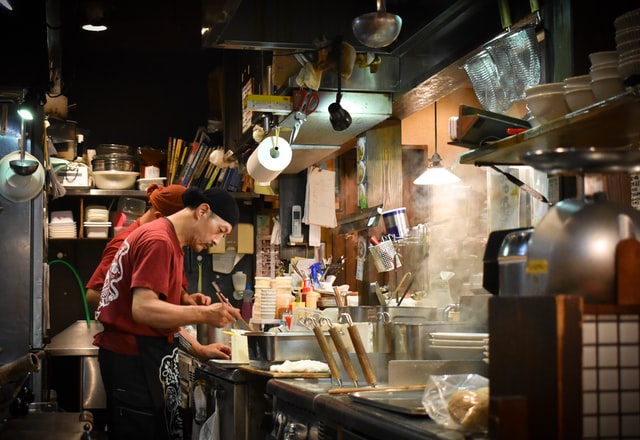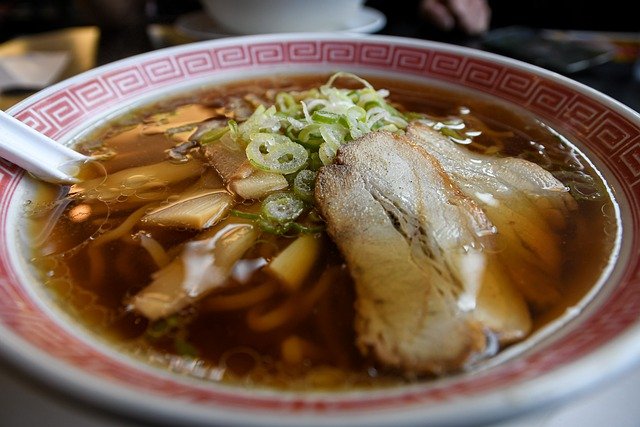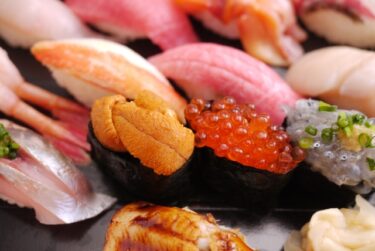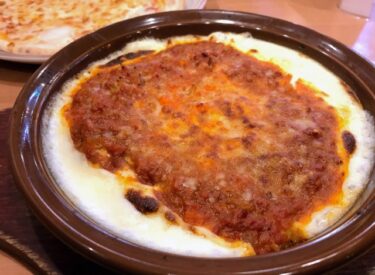Ramen is a hot soup noodle that is popular in Japan and uses noodles made from wheat flour.
You can eat it at ramen shops and/or Chinese restaurants.
There are numerous varieties, and regional soups and ingredients may be used. Cup noodles that can be eaten simply by pouring hot water are also popular.
What is Ramen and can I eat it?
Materials of Ramen
Noodle wheat flour, brine water, and salt, etc.
Soup chicken bones, pork bones, beef bones, bonito flakes, kelp, dried shiitake mushrooms, onions, green onions, ginger, and garlic etc.
Ingredients Sliced barbecued pork, boiled egg, green onion, menma, seaweed, and garlic, etc.
Materials vary depending on the restaurant and menu. Materials are not displayed in restaurants.
| High FODMAPs | ||||
| with Beef | with Pork | with Egg |
| Restaurant |
Ramen has a wide variety
Ramen is a popular noodle dish along with udon, soba, and pasta in Japan.
Originally introduced from China 130 years ago. After that, various improvements were made in Japan, and it evolved into its current form. Nowadays, it has a different shape from the original Chinese noodle dishes, so in China, Japanese ramen is called Japanese-style noodle to distinguish it.
Ramen in English is the pronunciation of ramen in Japanese.
Ramen, udon, and pasta are all made from wheat flour, but the noodles used are made differently.
Ramen is chewy and yellow because the noodles are made with brine water when kneading the dough. And there are various types of noodles, from thick to thin, straight to curly.
Ramen is often categorized by the type of the soup and the ingredients.

Main types of the soup are as follows;
Syouyu (Soy sauce) A soup is made from chicken bone, seafood, and soy sauce etc. It’s relatively light taste.
Shio (Salt) A soup is made from chicken bones and shellfish, and salt etc. It’s the lightest.
Miso Miso is a fermented seasoning made from soybeans and so on. The soup is made from chicken bone, seafood and miso etc.
Tonkotsu (Pork-bone) A rich soup made from pork bones seasoned with soy sauce and salt. It’s thick.

Ramen is also categorized according to the ingredients that are topped as follows;
Ramen Orthodox ingredients topped on the noodle are sliced barbecued pork, boiled egg, and green onion, menma.
Chāshū-men (sliced barbecued pork noodle) There are more sliced barbecued pork than normal ramen.
Champon Stir-fried seafood, vegetables, and kamaboko are on the noodle. The soup is made from pork bones, seafoods, and soy sauce. Originally it was a local food in Nagasaki, Kyusyu.
Tanmen Stir-fried meat and vegetables are on the noodle. The soup is often salty with chicken bone.
Try to eat Ramen!
How much ?
$6~15
Where can I eat Ramen?
Ramen restaurants

There are more than 22,000 ramen restaurant in Japan. You can easily find the restaurants at shopping malls, food court, large train stations and airports. Many testaurants are small in size. Bringing big luggage such as suitcases may be disliked.
Lunch is crowded between 11:00 and 14:00, so it is recommended to go at other times. There is no English menu except for ramen restaurants in big cities. Sometimes you should buy meal tickets at the entrance. Occasionally there are restaurants where only cash can be used.
Chinese restaurants
Most Chinese restaurants have ramen, but we don’t recommend it because of the small variety and relatively high price. The Chinese restaurant is larger than a ramen restaurant, and you can eat calmly at the table.
Convenience store
Various types of cup noodles are on sale. You can eat it just by pouring hot water, but it is not recommended because it tastes completely different from real ramen.
Precautions when eating Ramen
Dishes high in wheat
A dish of ramen contains about 100g of wheat flour and 15g of gluten. It is also a high FODMAPs food.
Pork and beef are used
Pork is often used as an ingredient. Even if pork and beef are not used as an ingredient, it may be in the soup.

Japanese writer’s comment for Ramen
Japanese love ramen, from children to adults. If you have no nutritional restrictions, we recommend that you try it once.

When choosing a ramen restaurant and menu, please refer to the impressions posted on SNS. This is the fastest way to meet delicious ramen.
Even if the ramen you ate is not your taste, don’t give up. There are many kinds of ramen, and each person has different tastes. Eating different ramen may feel delicious.
Noodles vary from thick to thin, but thin noodles are mainly eaten in the Kyushu region like Hakata ramen and Kumamoto ramen.



